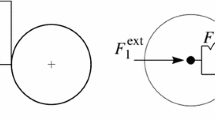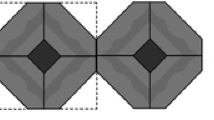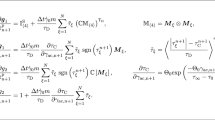Abstract
In this paper, an application of Arbitrary Lagrangian–Eulerian (ALE) method is presented in plasticity behavior of pressure-sensitive material, with special reference to large deformation analysis of powder compaction process. In ALE technique, the reference configuration is used for describing the motion, instead of material configuration in Lagrangian, and spatial configuration in Eulerian formulation. The convective term is used to reflect the relative motion between the mesh and the material. Each time-step is divided into the Lagrangian phase and Eulerian phase. The convection term is neglected in the material phase, which is identical to a time-step in a standard Lagrangian analysis. The stresses and plastic internal variables are converted to account the relative mesh-material motion in the convection phase. The ALE formulation is then performed within the framework of a three-invariant cap plasticity model in order to predict the non-uniform density distribution during the large deformation of powder die pressing. The plasticity model is based on a hardening rule with the isotropic and kinematic material functions. The constitutive elasto-plastic matrix and its components are derived by using the definition of yield surface, material functions and non-linear elastic behavior, as function of hardening parameters. Finally, the numerical examples are performed to illustrate the applicability of the computational algorithm in modeling of powder forming process and the results are compared with those obtained from Lagrangian simulation in order to demonstrate the accuracy of proposed model.
Similar content being viewed by others
References
Lewis RW, Khoei AR (1998) Numerical modeling of large deformation in metal powder forming. Comput Meth Appl Mech Eng 159: 291–328
Khoei AR, Lewis RW (1999) Adaptive finite element remeshing in a large deformation analysis of metal powder forming. Int J Numer Meth Engng 45: 801–820
Khoei AR, Azami AR, Anahid M, Lewis RW (2006) A three-invariant hardening plasticity for numerical simulation of powder forming processes via the Arbitrary Lagrangian–Eulerian FE model. Int J Numer Meth Engng 66: 843–877
Hughes TJR, Liu WK, Zimmermann TK (1981) Lagrangian– Eulerian finite element formulation for incompressible viscous flows. Comput Meth Appl Mech Eng 29: 329–349
Kennedy JM, Belytschko T (1981) Theory and application of a finite element method for Arbitrary Lagrangian–Eulerian fluids and structures. Nuclear Eng Design 68: 119–146
Haber RB (1984) A mixed Eulerian–Lagrangian displacement model for large-deformation analysis in solid mechanics. Comput Meth Appl Mech Eng 43: 277–292
Liu WK, Belytschko T, Chang H (1986) An Arbitrary Lagrangian– Eulerian finite element method for path-dependent materials. Comput Meth Appl Mech Eng 58: 227–245
Liu WK, Chang H, Chen JS, Belytschko T, Zhang YF (1988) Arbitrary Lagrangian–Eulerian Petrov–Galerkin finite elements for nonlinear continua. Comput Meth Appl Mech Eng 68: 259–310
Benson DJ (1989) An efficient, accurate, simple ALE method for nonlinear FE programs. Comput Meth Appl Mech Eng 72: 305–350
Schreurs PJG, Veldpaus FE, Brekelmans WAM (1986) Simulation of forming processes, using the arbitrary Eulerian–Lagrangian formulation. Comput Meth Appl Mech Eng 58: 19–36
Huetink J, Vreede PT, Lugt JVD (1990) Progress in mixed Eulerian–Lagrangian finite element simulation of forming processes. Int J Numer Meth Engng 30: 1441–1457
Ghosh S, Kikuchi N (1991) An Arbitrary Lagrangian–Eulerian finite element method for large deformation analysis of elastic- viscoplastic solids. Comput Meth Appl Mech Eng 86: 127– 188
Yamada T, Kikuchi F (1993) An arbitrary Lagrangian–Eulerian finite element method for incompressible hyperelasticity. Comput Meth Appl Mech Eng 102: 149–177
Huerta A, Casadei F (1994) New ALE applications in non-linear fast-transient solid dynamics. Eng Comput 11: 317–345
Pijaudier-Cabot G, Bodé L (1995) Arbitrary Lagrangian–Eulerian finite element analysis of strain localization in transient problems. Int J Numer Meth Engng 38: 4171–4191
Ghosh S, Raju S (1996) R-S adapted arbitrary Lagrangian– Eulerian finite element method of metal-forming with strain localization. Int J Numer Meth Engng 39: 3247–3272
Wang J, Gadala MS (1997) Formulation and survey of ALE method in nonlinear solid mechanics. Finite Elem Anal Design 24: 253–269
Gadala MS, Wang J (1998) ALE formulation and its application in solid mechanics. Comput Meth Appl Mech Eng 167: 33–55
Gadala MS, Wang J (1999) Simulation of metal forming processes with finite element method. Int J Numer Meth Engng 44: 1397–1428
Peery JS, Carroll DE (2000) Multi-material ALE methods in unstructured grids. Comput Meth Appl Mech Eng 187: 591–619
Davey K, Ward MJ (2002) A practical method for finite element ring rolling simulation using the ALE flow formulation. Int J Mech Sciences 44: 165–195
Rodriguez-Ferran A, Casadei F, Huerta A (1998) ALE stress update for transient and quasistatic processes. Int J Numer Meth Engng 43: 241–262
Rodriguez-Ferran A, Perez-Foguet A, Huerta A (2002) Arbitrary Lagrangian–Eulerian (ALE) formulation for hyperelastoplasticity. Int J Numer Meth Engng 53: 1831–1851
Armero F, Love E (2003) An arbitrary Lagrangian–Eulerian finite element method for finite strain plasticity. Int J Numer Meth Engng 57: 471–508
Bayoumi HN, Gadala MS (2004) A complete finite element treatment for the fully coupled implicit ALE formulation. Comput Mech 33: 435–452
Askes H, Rodrígues-Ferran A, Huerta A (1999) Adaptive analysis of yield line patterns in plates with the Arbitrary Lagrangian–Eulerian method. Comput Struct 70: 257–271
Gadala MS, Movahhedy MR, Wang J (2002) On the mesh motion for ALE modeling of metal forming processes. Finite Elem Anal Design 38: 435–459
Aymone JLF (2004) Mesh motion techniques for the ALE formulation in 3D large deformation problems. Int J Numer Meth Engng 59: 1879–1908
Belytschko T, Liu WK, Moran B (2000) Nonlinear finite elements for continua and structures. Wiley, New York
Herrmann LR (1976) Laplacian-isoparametric grid generation scheme. J Engng Mech Div 102: 749–756
Fleck NA (1995) On the cold compaction of powders. J Mech Phys Solids 43: 1409–1431
Ransing RS, Gethin DT, Khoei AR, Mosbah P, Lewis RW (2000) Powder compaction modelling via the discrete and finite element method. J Mat Des 21: 263–269
McMeeking RM, Jefferson G, Haritos GK (2001) Elastic and viscoelastic response of finite particle junctions in granular materials. In: Zavaliangos A, Laptev A (eds) Recent development in computer modeling of powder metallurgy process. IOS Press, Amterdam
Lewis RW, Jinka AGK, Gethin DT (1993) Computer aided simulation of metal powder die compaction process. Powder Metallurgy Int 25: 287–293
Brown SB, Weber GGA (1988) A constitutive model for the compaction of metal powders. Modern Dev Powder Metall 18: 465– 476
Chenot JL, Bay F, Fourment L (1990) Finite element simulation of metal powder forming. Int J Numer Meth Engng 30: 1649– 1674
Brekelmans WAM, Janssen JD, Van de Ven AAF, de With G (1991) An Eulerian approach for die compaction processes. Int J Num Meth Eng 31: 509–524
Haggblad HA, Oldenburg M (1994) Modeling and simulation of metal powder die pressing with use of explicit time integration. Model Simul Mater Sci Eng 2: 893–911
Watson TJ, Wert JA (1993) On the development of constitutive relations for metallic powders. Metallurgical Trans 24: 1993– 2071
Brown S, Abou-Chedid G (1994) Yield behavior of metal powder assemblages. J Mech Phys Solids 42: 383–398
Aydin I, Briscoe BJ, Sanliturk KY (1996) The internal form of compacted ceramic components. A comparison of a finite element modeling with experiment. Powder Tech 89: 239–254
Khoei AR, Lewis RW (1998) Finite element simulation for dynamic large elasto-plastic deformation in metal powder forming. Finite Elem Anal Des 30: 335–352
Brandt J, Nilsson L (1999) A constitutive model for compaction of granular media, with account for deformation induced anisotropy. Mech Cohes Frict Mater 4: 391–418
Gu C, Kim M, Anand L (2001) Constitutive equations for metal powders:application to powder forming processes. Int J Plast 17: 147–209
Lewis RW, Khoei AR (2001) A plasticity model for metal powder forming processes. Int J Plast 17: 1659–1692
Khoei AR, Bakhshiani A, Mofid M (2003) An endochronic plasticity model for finite strain deformation of powder forming processes. Finite Elem Analy Des 40: 187–211
Khoei AR, Bakhshiani A (2004) A hypoelasto-plastic finite strain simulation of powder compaction processes with density dependent endochronic model. Int J Solids Struct 41: 6081–6110
Khoei AR, Azami AR (2005) A single cone-cap plasticity with an isotropic hardening rule for powder materials. Int J Mech Sci 47: 94–109
Khoei AR, DorMohammadi H (2007) A three-invariant cap plasticity with isotropic–kinematic hardening rule for powder materials. Comput Mat Sci
Khoei AR (2005) Computational plasticity in powder forming processes. Elsevier, UK
Doremus P, Geindreau C, Marttin A, Debove L, Lecot R, Dao M (1995) High pressure triaxial cell for metal powder. Powder Metall 38: 284–287
Azami AR, Khoei AR (2006) 3D computational modeling of powder compaction processes using a three-invariant hardening cap plasticity model. Finite Elem Anal Des 42: 792–807
Khoei AR, Bakhshiani A, Mofid M (2003) An implicit algorithm for hypoelasto-plastic and hypoelasto-viscoplastic endochronic in finite strain isotropic–kinematic hardening model. Int J Solids Struct 40: 3393–3423
Shen WM, Kimura T, Takita K, Hosono K (2001) Numerical simulation of powder transfer and compaction based on continuum model. In: Mori K (ed) Simulation of materials processing: theory, methods and applications, pp 1027–1032
Author information
Authors and Affiliations
Corresponding author
Rights and permissions
About this article
Cite this article
Khoei, A.R., Anahid, M., Shahim, K. et al. Arbitrary Lagrangian–Eulerian method in plasticity of pressure-sensitive material: application to powder forming processes. Comput Mech 42, 13–38 (2008). https://doi.org/10.1007/s00466-007-0232-4
Received:
Accepted:
Published:
Issue Date:
DOI: https://doi.org/10.1007/s00466-007-0232-4




